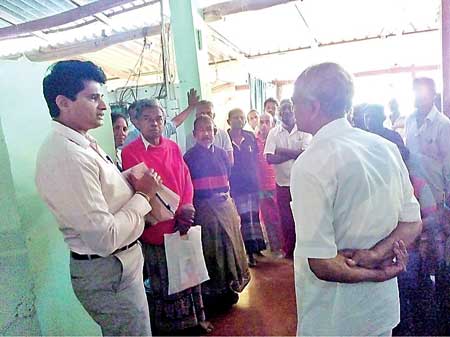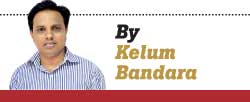Insights from traditional medicine to treat Chronic Kidney Disease
Posted on May 26th, 2017
Dr. Channa Jayasumana Daily Mirror
- Western Medicine can only manage the disease
- Identical disease is found in Central America
- After treatment by a Sinhala Vedamahattaya, patients see improvements
Dr. Channa Jayasumana, Head of the Department of Pharmacology at Rajarata Medical Faculty who has conducted extensive research into Chronic Renal Failure in Sri Lanka, recently participated at the World Congress of Nephrology (WCN) in Mexico and submitted his research. He says valuable insights can be derived from traditional medicine to reverse the disease.

QYou recently made a presentation in Mexico on Chronic Kidney Disease (CKD), a disease that has afflicted the agricultural communities of Sri Lanka. What did you present?
It was the World Congress of Nephrology (WCN), organized by the International Society of Nephrology (ISN). It is an academic event held once in two years. All world-renowned Nephrologists and scientists in the Nephrology field attended the event. This time there were 4,000 participants cutting across the globe, representing 120 countries. The latest research findings on kidney diseases, their management and proposed future research ideas were presented at this event. I had the opportunity of delivering a lecture at ISN-WCN. In fact, I was the only speaker from Sri Lanka. There were speakers from India, Pakistan and China. Most were from the US or Europe.
QWhat are your latest research findings?
Our main research is focused on the kidney disease prevalent among the paddy growers in the dry zone of Sri Lanka. An identical disease is found in the Central American region among sugarcane cultivators. We did a multi-centered study involving Sri Lankan, Nicaraguan, El Salvadorian and Swedish scientists. First, our group did a renal biopsy study in El Salvador. The Swedish scientists had brought renal tissue samples to the Karolinska Institute, a renowned medical research institute which awards Nobel prizes in medicine. We did the second study involving patients from Nicaragua. Swedish collaborators came to Sri Lanka last year. We did a renal biopsy study at the Polonnaruwa Hospital with the help of Dr. Rajiva Dasanayake, a Nephrologist. We transported samples from Polonnaruwa to Stockholm for analysis. Finally, we compared all these renal tissue samples taken from three different countries. We analysed the biochemical parameters of these patients, covering all aspects of urine and blood. We analysed early renal markers too. Upon comparison of all these samples, we found the two diseases to be very similar. One is found among paddy growers in this part of the globe and the other among sugarcane farmers. It is an interesting find. We can discover various infectious diseases among people from different parts of the world. In this instance, it is identical. It is a chronic, non-communicable disease. Yet, the histopathological and biochemical pictures are the same. There is no genetic relation between the people of the Central American region and Sri Lanka but we observed the similarity. The main difference was that certain microvasculature changes (glomerular ischemia) in the renal tissues were affected more in Central America. For the moment, I assume it may be due to their strenuous physical activity.

We presented the preliminary results at the Mexico City World Congress of Nephrology. It will be published in a high impact medical journal soon. The disease emerged in these two regions in the mid 1990s. Both regions are in the tropics. There is high temperature and humidity in both regions. Rice and sugarcane belong to the same grass family. The types and usage levels of agro-chemicals for both crops are quite similar. We have observed a large quantity of weedicide and insecticide being used for both cultivations. In addition, both are high-fertilizer consuming plants.
QYou did some studies on this disease involving indigenous medicinal practices. What are your findings and observations?
It is really interesting. Actually, we only control the disease (CKD) with western medicine. By definition, Chronic Kidney Disease causes irreversible damage to renal tissues. Once your renal tissues are affected, you cannot reverse the damage. We are just trying to stop the further damage. Also, we try to delay the development of complications. These are the CKD management goals in western medicine.
Our main research is focused on the kidney disease prevalent among the paddy growers in the dry zone of Sri Lanka
In the meantime, we received information that certain Sinhala ‘Veda Mahattayas’ (Indigenous medicine practitioners) knew of some methods to reverse the renal damage. Then, we did a basic survey. We found that certain patients from Anuradhapura and Kurunegala were cured of this disease. There is a famous Veda Mahattaya in Anuradhapura called ‘Alayapattuwe Vedamahattaya’. We did a collaborative study with the participation of experts from the Rajarata University and Ruhuna University. We selected a few patients and referred them to the Veda Mahattaya to be treated. We  did not do intervene. We only observed what he was doing. At the recruitment, we did all the chemical parameters related to renal functions. We continued it for four weeks. After that, we gave them a standard questionnaire. There is a medical way of assessing patients’ compliance and feelings. For the first batch, we recruited 50 patients, and another 50 for the second batch. For the third month, we also selected 50. We found that the renal functions of most of these patients improved after a treatment of four weeks. Clinically and psychologically they showed improvements.
did not do intervene. We only observed what he was doing. At the recruitment, we did all the chemical parameters related to renal functions. We continued it for four weeks. After that, we gave them a standard questionnaire. There is a medical way of assessing patients’ compliance and feelings. For the first batch, we recruited 50 patients, and another 50 for the second batch. For the third month, we also selected 50. We found that the renal functions of most of these patients improved after a treatment of four weeks. Clinically and psychologically they showed improvements.
QIs that a remarkable improvement?
Yes. In medical terms, we call it a statistically significant improvement. There is a way of quantifying the quality too. There is a significant improvement of the quality of life of these patients, according to the information gathered through standard medical questionnaires. These results were compatible with chemical parameters of the body.
QHow does the Veda Mahattaya treat these patients?
We observed this Veda Mahattaya collecting herbal plants from the Wilapptu forest and the Medawachchiya area. The majority of them were endemic plant varieties. He gave herbal items made of these plants to patients on a daily basis, according to a schedule. The patients had to wake up at 5.30 am and participate in some Buddhist religious ritual and meditation. Treatment is not only confined to the physical body but also to the mind. It is done in keeping with Theravada Buddhist religious practices. Patients have to practice the schedule for one month. There is a strict control of food. Food from outside was not allowed. It was supplied by the Veda Mahattaya. We even analysed the food stuff provided. We found it to be a low-protein diet. It is the same as practiced in western medicine in the management of CKD. Certain herbal oils and dermal preparations were given. After a couple of weeks, signs of improvement become visible. After four weeks, there was dramatic improvement.
 Patients from Anuradhapura and Kurunegala
Patients from Anuradhapura and Kurunegala
QNormally, western medical practitioners do not encourage indigenous medicine. You are an exception. What compelled you to accept this?
At present, authentic Sinhala Vedamahattayas are confined only to a few areas. Many others practicing it misuse the system. It has become a money-making business for them (in this particular instance, the Vedamahattaya did not charge anything). This is why western doctors see it from a different angle. We see quacks in many places treating people, posing as indigenous medical practitioners. There are good ones here and there. I am not finding fault with western doctors for having a different view. However as intellectuals, we have to differentiate between these genuine practitioners. We have to respect the Sinhala medicine system too. It has a separate knowledge system developed through millennia. Usually knowledge in Sinhala medicine is preserved and transferred in the form of four line verses (Sivu Pada). One cannot neglect this knowledge system merely by calling it unscientific. Before the introduction of the western system, we had an advanced system. You find it in ancient literature. The large edifices built in the Anuradhapura era could not have been erected if not for the existence of a healthy population. We have to accept that we had a very good medical system.
As intellectuals, we have to investigate the roots of our medicine. One way is to absorb the indigenous medicine system to the western system
As intellectuals, we have to investigate the roots of our medicine. One way is to absorb the indigenous medicine system to the western system. The second is to adapt the western system to ours. Nowadays, we do not have adequate intellectuals on our side to carry out the second. Thus we have to absorb our knowledge into the western system for the time being. For example, we have two consultants at our medical faculty – a surgeon and consultant physician. They use indigenous techniques to treat anal fistula. It is a successful treatment. They have absorbed the indigenous knowledge to the western system and successfully conduct it.
There are intellectuals in the field who can see this with an open mind. They appreciate it. It is a good trend. At the same time, there are others who do not trust any other knowledge system except the western one. They criticise us. They feel that our efforts will yield no results.
We have unique medical issues for which western medicine does not have answers. The CKD epidemic among paddy farmers is a classic example. Western companies and universities do not invest in the research as it does not concern their population. It involves a lot of money, probably millions of dollars. They invest in research into diseases such diabetes and hypertension. So we have to find our own solution. I do not feel we have a good western research system in the country. Most research done here are pseudo ones done just as academic papers for passing examinations for academic posts. What is the result of the research work done in the last 50 years? What is the amount of money we spent in the name of research? Can you name a single drug developed in this manner? We are just repeating work done by the western world. At least now we can identify our roots and develop a genuine research tradition.